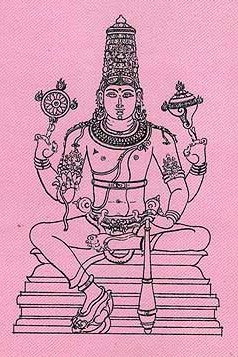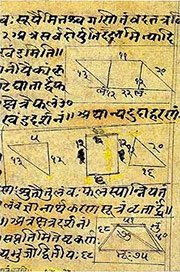Bhupati, Bhūpati, Bhu-pati: 20 definitions
Introduction:
Bhupati means something in Buddhism, Pali, Hinduism, Sanskrit, Marathi. If you want to know the exact meaning, history, etymology or English translation of this term then check out the descriptions on this page. Add your comment or reference to a book if you want to contribute to this summary article.
In Hinduism
Purana and Itihasa (epic history)
Source: archive.org: Puranic EncyclopediaBhūpati (भूपति).—A viśvadeva. (Mahābhārata Anuśāsana Parva, Chapter 91, Verse 32).

The Purana (पुराण, purāṇas) refers to Sanskrit literature preserving ancient India’s vast cultural history, including historical legends, religious ceremonies, various arts and sciences. The eighteen mahapuranas total over 400,000 shlokas (metrical couplets) and date to at least several centuries BCE.
Ayurveda (science of life)
Nighantu (Synonyms and Characteristics of Drugs and technical terms)
Source: WorldCat: Rāj nighaṇṭuBhūpati (भूपति) is another name for Ṛṣabhaka, a medicinal plant possibly identified with Microstylis muscifera Ridley which is a synonym of Malaxis muscifera (Lindl.) or “fly bearing malaxis” from the Orchidaceae or “orchid” family of flowering plants, according to verse 5.14-16 of the 13th-century Raj Nighantu or Rājanighaṇṭu. The fifth chapter (parpaṭādi-varga) of this book enumerates sixty varieties of smaller plants (kṣudra-kṣupa). Together with the names Bhūpati and Ṛṣabhaka, there are a total of twenty Sanskrit synonyms identified for this plant.

Āyurveda (आयुर्वेद, ayurveda) is a branch of Indian science dealing with medicine, herbalism, taxology, anatomy, surgery, alchemy and related topics. Traditional practice of Āyurveda in ancient India dates back to at least the first millenium BC. Literature is commonly written in Sanskrit using various poetic metres.
Jyotisha (astronomy and astrology)
Source: Wisdom Library: Brihat Samhita by VarahamihiraBhūpati (भूपति) refers to a “prince”, according to the Bṛhatsaṃhitā (chapter 2), an encyclopedic Sanskrit work written by Varāhamihira mainly focusing on the science of ancient Indian astronomy astronomy (Jyotiṣa).—Accordingly, “[...] The evils of bad dreams, of sad thoughts, of ill omens and of evil deeds and the like will vanish immediately when one hears of the moon’s motion among the stars. Neither the father nor the mother nor the relations nor friends of a prince [i.e., bhūpati] will desire so much his well being and that of his subjects as a true Jyotiṣaka”.

Jyotisha (ज्योतिष, jyotiṣa or jyotish) refers to ‘astronomy’ or “Vedic astrology” and represents the fifth of the six Vedangas (additional sciences to be studied along with the Vedas). Jyotisha concerns itself with the study and prediction of the movements of celestial bodies, in order to calculate the auspicious time for rituals and ceremonies.
Pancaratra (worship of Nārāyaṇa)
Source: University of Vienna: Sudarśana's Worship at the Royal Court According to the AhirbudhnyasaṃhitāBhūpati (भूपति) refers to the “master of the earth”, according to the Ahirbudhnyasaṃhitā, belonging to the Pāñcarātra tradition which deals with theology, rituals, iconography, narrative mythology and others.—Accordingly, “For only the Court Officiant accomplishes for Kings all seen and unseen aims, especially when this Deity is installed, worshipped and so on. Any defectiveness of his (i.e. of the King) is due to the faults of the Court Officiant, and similarly [every] excellence of the same King in [the performance of] rituals [depends on the Officiant], oh Master of the Earth (bhūpati)!”.

Pancaratra (पाञ्चरात्र, pāñcarātra) represents a tradition of Hinduism where Narayana is revered and worshipped. Closeley related to Vaishnavism, the Pancaratra literature includes various Agamas and tantras incorporating many Vaishnava philosophies.
Ganitashastra (Mathematics and Algebra)
Source: archive.org: Hindu MathematicsBhūpati (भूपति) represents the number 16 (sixteen) in the “word-numeral system” (bhūtasaṃkhyā), which was used in Sanskrit texts dealing with astronomy, mathematics, metrics, as well as in the dates of inscriptions and manuscripts in ancient Indian literature.—A system of expressing numbers by means of words arranged as in the place-value notation was developed and perfected in India in the early centuries of the Christian era. In this system the numerals [e.g., 16—bhūpati] are expressed by names of things, beings or concepts, which, naturally or in accordance with the teaching of the Śāstras, connote numbers.

Ganitashastra (शिल्पशास्त्र, gaṇitaśāstra) refers to the ancient Indian science of mathematics, algebra, number theory, arithmetic, etc. Closely allied with astronomy, both were commonly taught and studied in universities, even since the 1st millennium BCE. Ganita-shastra also includes ritualistic math-books such as the Shulba-sutras.
Shaivism (Shaiva philosophy)
Source: SOAS University of London: Protective Rites in the Netra TantraBhūpati (भूपति) refers to the “king”, according to the Netratantra of Kṣemarāja: a Śaiva text from the 9th century in which Śiva (Bhairava) teaches Pārvatī topics such as metaphysics, cosmology, and soteriology.—Accordingly, [verse 19.85cd-87, while describing the ritual that protect the king and his kingdom]—“This [pūjā] should prevent all suffering to arise in [the one who performs it]. [The Mantrin] should perform [it] for his devoted wives, children, and his devoted pupils; he should not practice it otherwise. [When he conducts the pūjā, he should do so] on behalf of kings (bhūpati) and their offspring because, the king is always the head [of the family] of all stages of life [i.e., the king is always the head of all families in the kingdom, regardless of the status of his subjects]”.

Shaiva (शैव, śaiva) or Shaivism (śaivism) represents a tradition of Hinduism worshiping Shiva as the supreme being. Closely related to Shaktism, Shaiva literature includes a range of scriptures, including Tantras, while the root of this tradition may be traced back to the ancient Vedas.
In Buddhism
Tibetan Buddhism (Vajrayana or tantric Buddhism)
Source: Brill: Śaivism and the Tantric Traditions (tantric Buddhism)Bhūpati (भूपति) refers to the “king”, according to Kuladatta’s Kriyāsaṃgrahapañjikā, a text within Tantric Buddhism representing a construction manual for monasteries.—Accordingly, [while describing pratiṣṭhā in chapter 4]—“Then the king (bhūpati) should satisfy the architects, the assistants, and the spectators with a bracelet, a finger-ring, a garment, gold, heap of chaplet, tāmbūla, or other [articles] according to [the donor’s] wealth”.
Source: OSU Press: Cakrasamvara SamadhiBhūpati (भूपति) refers to the “lord of the earth”, according to the Guru Mandala Worship (maṇḍalārcana) ritual often performed in combination with the Cakrasaṃvara Samādhi, which refers to the primary pūjā and sādhanā practice of Newah Mahāyāna-Vajrayāna Buddhists in Nepal.—Accordingly, “Agni, Yama, Nirṛiti, lord of the earth (bhūpati), lord of water, Vāyu, and lord of wealth, Īśāna, lord of all beings and gods, and above the sun, moon and Brahmā. All gods whoever in the earth and nāgas, mountains with secret assemblies, Being a counter to, do once offer, the ghosts in each of your own directions. [...]”.

Tibetan Buddhism includes schools such as Nyingma, Kadampa, Kagyu and Gelug. Their primary canon of literature is divided in two broad categories: The Kangyur, which consists of Buddha’s words, and the Tengyur, which includes commentaries from various sources. Esotericism and tantra techniques (vajrayāna) are collected indepently.
Languages of India and abroad
Marathi-English dictionary
Source: DDSA: The Molesworth Marathi and English Dictionarybhūpati (भूपति).—m (S) A king. S adage. bhūpatirvā yatirvā (I will be) a king or a yati, an all possessing lord or a nothing-needing sage.
Source: DDSA: The Aryabhusan school dictionary, Marathi-Englishbhūpati (भूपति).—m A king.
Marathi is an Indo-European language having over 70 million native speakers people in (predominantly) Maharashtra India. Marathi, like many other Indo-Aryan languages, evolved from early forms of Prakrit, which itself is a subset of Sanskrit, one of the most ancient languages of the world.
Sanskrit dictionary
Source: DDSA: The practical Sanskrit-English dictionaryBhūpati (भूपति).—
1) a king.
2) an epithet of Śiva.
3) of Indra.
Derivable forms: bhūpatiḥ (भूपतिः).
Bhūpati is a Sanskrit compound consisting of the terms bhū and pati (पति).
Source: Cologne Digital Sanskrit Dictionaries: Shabda-Sagara Sanskrit-English DictionaryBhūpati (भूपति).—m.
(-tiḥ) A king, a sovereign. E. bhū the earth, and pati master.
Source: Cologne Digital Sanskrit Dictionaries: Benfey Sanskrit-English DictionaryBhūpati (भूपति).—m. a king, [Pañcatantra] i. [distich] 262.
Bhūpati is a Sanskrit compound consisting of the terms bhū and pati (पति).
Source: Cologne Digital Sanskrit Dictionaries: Cappeller Sanskrit-English DictionaryBhūpati (भूपति).—[masculine] lord of beings (Rudra) or of the earth (a king).
Source: Cologne Digital Sanskrit Dictionaries: Aufrecht Catalogus CatalogorumBhūpati (भूपति) as mentioned in Aufrecht’s Catalogus Catalogorum:—Gaṇitāmṛta.
Source: Cologne Digital Sanskrit Dictionaries: Monier-Williams Sanskrit-English Dictionary1) Bhūpati (भूपति):—[=bhū-pati] m. (bhū-) ‘lord of the earth’, Name of Rudra, [Taittirīya-saṃhitā; Taittirīya-brāhmaṇa; Āśvalāyana-śrauta-sūtra]
2) [v.s. ...] of Indra, [???]
3) [v.s. ...] of Baṭuka-bhairava, [cf. Lexicographers, esp. such as amarasiṃha, halāyudha, hemacandra, etc.]
4) [v.s. ...] of one of the Viśve-Devāḥ, [Mahābhārata]
5) [v.s. ...] a king, monarch, prince, [Mahābhārata; Rāmāyaṇa; Raghuvaṃśa] etc.
6) [v.s. ...] a [particular] bulbous plant existing on the Himavat, [cf. Lexicographers, esp. such as amarasiṃha, halāyudha, hemacandra, etc.]
7) [v.s. ...] a [particular] Rāga, [Saṃgīta-sārasaṃgraha]
8) [v.s. ...] Name of a poet (perhaps Bhoja; cf. bhū-pāla), [Catalogue(s)]
9) [v.s. ...] of an author, [Catalogue(s)]
10) [v.s. ...] of a priest of the gods, [cf. Lexicographers, esp. such as amarasiṃha, halāyudha, hemacandra, etc.]
11) [v.s. ...] [plural] Name of a [particular] class of gods under Manu Raivata, [Mārkaṇḍeya-purāṇa]
Source: Cologne Digital Sanskrit Dictionaries: Yates Sanskrit-English DictionaryBhūpati (भूपति):—[bhū-pati] (tiḥ) 2. m. A king.
[Sanskrit to German]
Sanskrit, also spelled संस्कृतम् (saṃskṛtam), is an ancient language of India commonly seen as the grandmother of the Indo-European language family (even English!). Closely allied with Prakrit and Pali, Sanskrit is more exhaustive in both grammar and terms and has the most extensive collection of literature in the world, greatly surpassing its sister-languages Greek and Latin.
Kannada-English dictionary
Source: Alar: Kannada-English corpusBhūpati (ಭೂಪತಿ):—
1) [noun] = ಭೂಪ - [bhupa -] 1 & 2.
2) [noun] a particular bulbuous plant existing in the Himalaya region.
Kannada is a Dravidian language (as opposed to the Indo-European language family) mainly spoken in the southwestern region of India.
See also (Relevant definitions)
Starts with: Bhupatimatre, Bhupatistuti, Bhupatita, Bhupativeshman.
Ends with: Atavikabhupati, Bukkabhupati, Phatihabhupati, Pravarabhupati, Punarbhupati, Shishubhupati, Shivalinga bhupati, Shivalinga colabhupati, Vaijalabhupati, Virabhupati.
Full-text (+32): Bhupatistuti, Kramayata, Bhupativeshman, Bhupatimatre, Vaijaladeva, Shishubhupati, Pravarabhupati, Nagnabhupatigraha, Phatihabhupati, Shivalinga bhupati, Bhuvabhartar, Virabhupati, Kalatikrama, Pravarasena, Ganitamrita, Kalakramana, Caturvedatatparyasamgraha, Girishasuktimala, Kramagata, Stutisuktimala.
Relevant text
Search found 20 books and stories containing Bhupati, Bhu-pati, Bhū-pati, Bhūpati; (plurals include: Bhupatis, patis, Bhūpatis). You can also click to the full overview containing English textual excerpts. Below are direct links for the most relevant articles:
Bharadvaja-srauta-sutra (by C. G. Kashikar)
Kavyamimamsa of Rajasekhara (Study) (by Debabrata Barai)
Part 5.2 - Speech and Languages of Kavi (poets) < [Chapter 5 - Analyasis and Interpretations of the Kāvyamīmāṃsā]
Appendix 1 - Ācārya, Kavi and important persons mentioned in the Kāvyamīmāṃsā
Rig Veda (translation and commentary) (by H. H. Wilson)
Rig Veda 10.51.6 < [Sukta 51]
Nitiprakasika (Critical Analysis) (by S. Anusha)
Middle Chola Temples (by S. R. Balasubrahmanyam)
Temples in Tirukkalar < [Chapter II - Temples of Rajaraja I’s Time]
Temples in Agaram (South Arcot) < [Chapter II - Temples of Rajaraja I’s Time]
The history of Andhra country (1000 AD - 1500 AD) (by Yashoda Devi)
Part 24 - Visvesvara (A D. 1377-1407) and Choda Ganga (A.D. 1391-1417) < [Chapter XI - The Chalukyas]